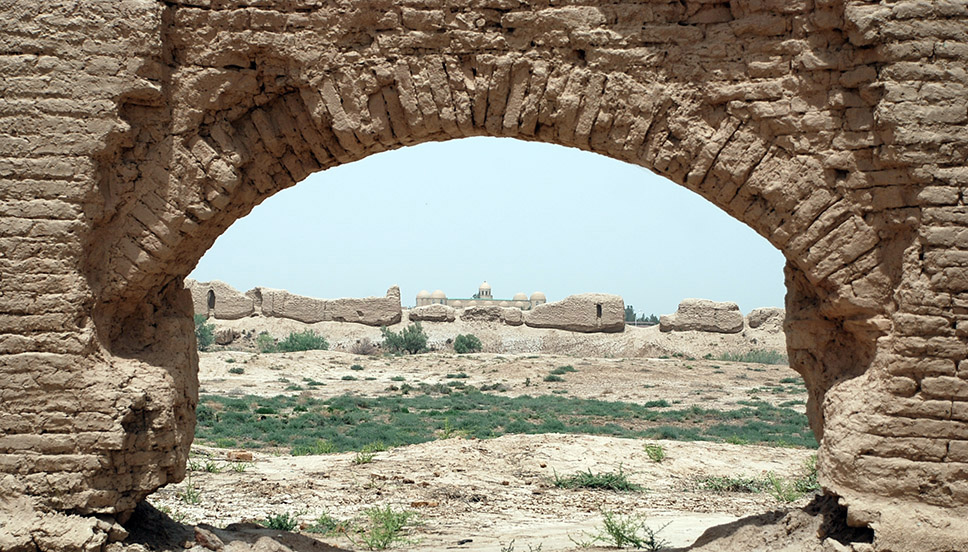Kunya Urgench city and Khorezmshahs
(Since 2005 on UNESCO list of World Heritage Sites, in Turkmenistan)
Kunya Urgench was a major regional centre from 10th to the 13th centuries and in the 12th century became the capital of the Khanate of Khorezm. The city destroyed by the Mongols in the early 13th century, rebuilt under the rule of the Golden Horde.
 Timur destroyed it again in the 14th century, then partially rebuilt and finally abandoned in the 16th century when the river changed its course. A new city was established at the site of Khiva near modern day Urgench, 150 km up stream of Amu Darya river. The remains of the Kunya Urgench city are still very significant. There are a number of mausolea, a minaret and traces of the ancient walled city, including a monumental gateway.
Timur destroyed it again in the 14th century, then partially rebuilt and finally abandoned in the 16th century when the river changed its course. A new city was established at the site of Khiva near modern day Urgench, 150 km up stream of Amu Darya river. The remains of the Kunya Urgench city are still very significant. There are a number of mausolea, a minaret and traces of the ancient walled city, including a monumental gateway.
The beginning of Khorezmshah dynasty starts with Anush Tigin Gharchai. A former Turkic commander of Seljuk Sultan then appointed as the governor of Khorezm. His origin probably comes from Oghuz tribe Begdili of the Bozok confederation branch. However, some scholars refer to the Eastern Turkic tribes. Khorezm was a vassal of Seljuk Sultans and paid them a tribute. His son, Qutb ad-Din Muhammed, 1097 – 1127, had the first of Khorezmshah title.
Next Khorezmshah, Ala ad-Din Atsiz, 1127- 1156. Being a vassal of Seljuks, he played also an important role on the side of Qara Khitai alliance, together with Karluks tribes. This resulted to the battle of Qatwan near Samarkand, where the Seljuk Sultan's army have been decisively defeated. Sultan Sanjar ran from battlefield, his wife was captured. Khorezmshah became a vassal of Qara Khitai, paying annual tribute of 30,000 dinars and still nominally remaining under suzerainty of Seljuks.
 His son, Khorezmshah Il Arslan, 1156-1172, after the death of Sultan Sanjar broke the Seljuk suzerainty and started to expand the lands southwards into Seljuks empire. Il Arslan had two sons, and one of them became next Khorezmshah Ala ad-Din Tekesh in 1172-1200 (who strikes in battle). He continued the expansion of the Khorezm state. In 1194, together with alliance of Caliph Al Nasir (Abbasid Caliph in Baghdad from 1180), they defeated the last Seljuk Sultan of Hamadan, Toghrul III. However, later he broke with Caliphate and was on the brink of war until the caliph accepted him as Sultan of Turkestan, Khorasan and Iran in 1198.
His son, Khorezmshah Il Arslan, 1156-1172, after the death of Sultan Sanjar broke the Seljuk suzerainty and started to expand the lands southwards into Seljuks empire. Il Arslan had two sons, and one of them became next Khorezmshah Ala ad-Din Tekesh in 1172-1200 (who strikes in battle). He continued the expansion of the Khorezm state. In 1194, together with alliance of Caliph Al Nasir (Abbasid Caliph in Baghdad from 1180), they defeated the last Seljuk Sultan of Hamadan, Toghrul III. However, later he broke with Caliphate and was on the brink of war until the caliph accepted him as Sultan of Turkestan, Khorasan and Iran in 1198.
Ala ad-Din Tekesh's son was the last Khorezmshah, Ala ad-Din Muhammad who governed the Khorezm state until the Mongol invasion in 1221. His disregard to the Genghis Khan's trade agreement mission, the mockery and execution of the Mongol Ambassadors, finally provoked this invasion. Having big army, he did not meet the Mongols on the open battlefield but preferred to defend each town separately, what was mistake. The Mongols took each town at a time, defeating its garrisons. When they arrived at Kunya Urgench, just east of the city was a dam that irrigated the area and blocked the flow of the Oxus (Amu Darya River) into the Caspian Sea. Mongols destroyed this dam and then destroyed Kunya Urgench transforming the area into a marsh.
The city was revived and became again the largest, greatest and most beautiful, important city of the Turks, as wrote the travelers of 14th century period. In 1388, the Sufi dynasty revolted against Timur. This time Timur came with the army and razed it to the ground, destroyed the irrigation system. This destruction, together with Amu Darya River course change were the factors of Kunya Urgench final decline and complete abandon in 16th century. It was replaced by Khiva and then later by Urgench, what is now in Uzbekistan.
